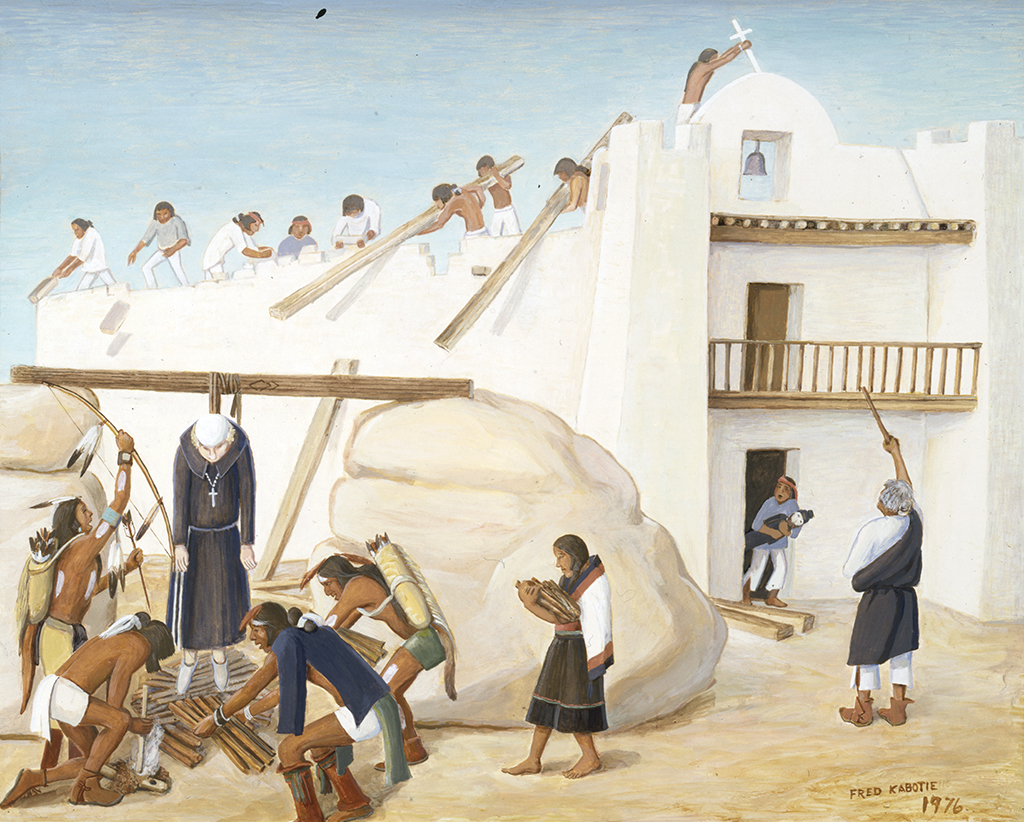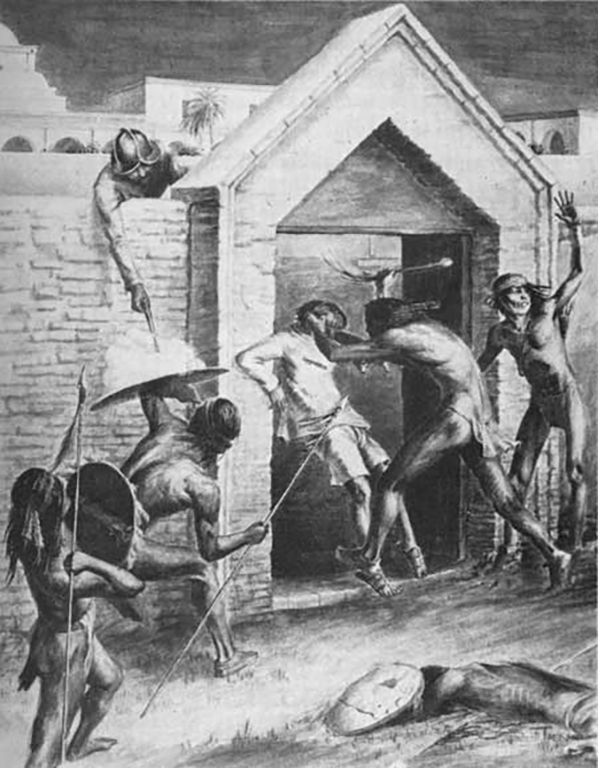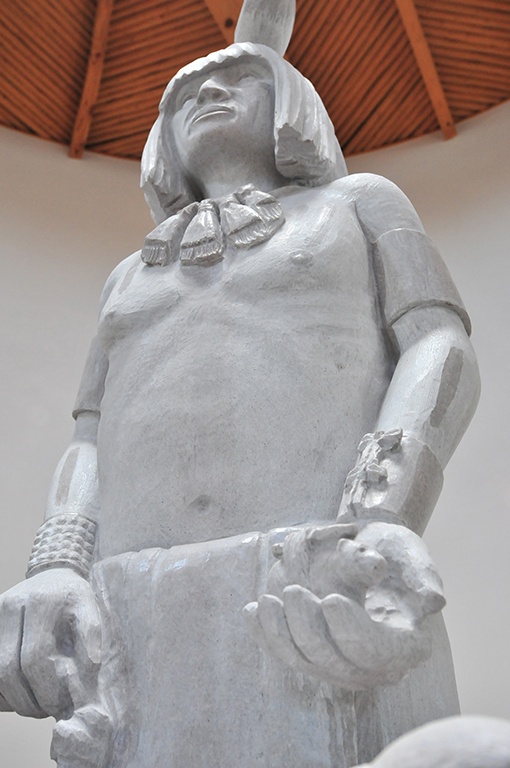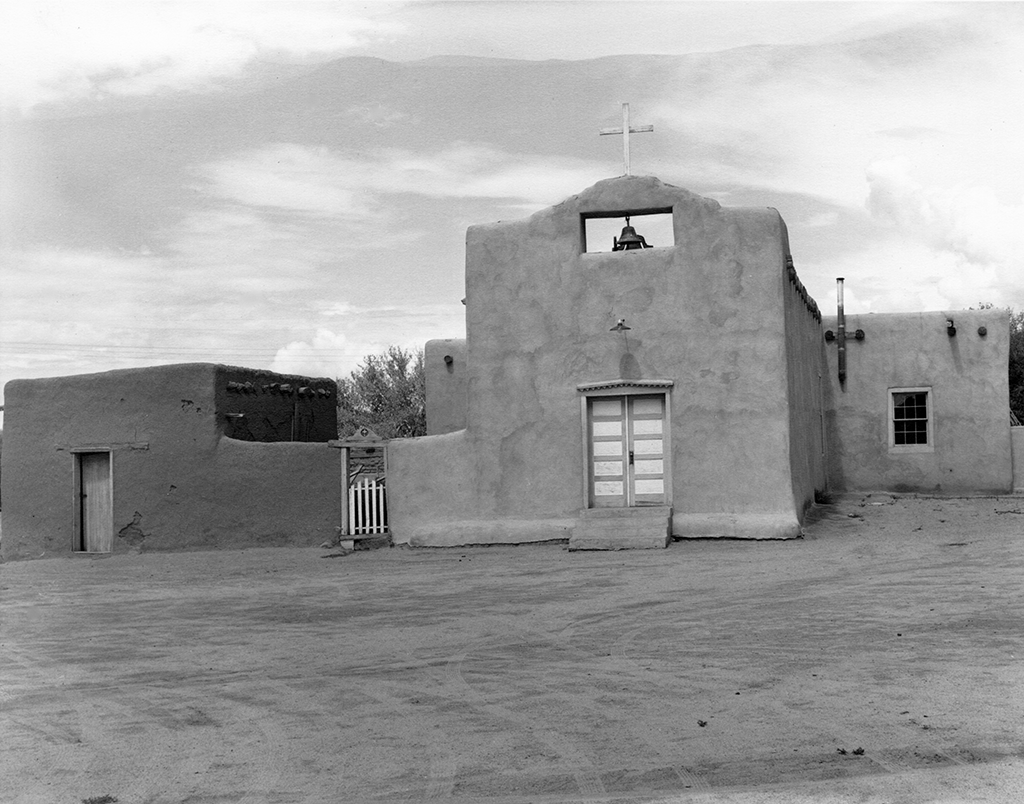The History of New Mexico
Collapse
Expand
-
Chapter 4: Spanish Colonization of New Mexico, 1598-1700
- Spanish Colonization of New Mexico, 1598-1700
- Toward New Mexico
- Oñate & Initial Spanish Colonization
- Oñate's Troubled Tenure
- Building a Royal Colony
- "The First American Revolution"
- References & Further Reading
On August 16, 1680, the inhabitants of Santa Fe faced a dire situation. A combined force of Pueblo, Apache, and mestizo warriors laid siege to their community. All water and supplies were cut off. War leader Juan el Tano presented Governor Antonio de Otermín with a stark choice, symbolized by two crosses. If the governor chose the white cross he would agree to abandon New Mexico forever. If he chose the red cross it would signify his intent to continue the fight. Rather than fully surrender, Otermín led a final military charge against the assailants. In the attack, three hundred natives lost their lives, another forty-seven were captured, and about 1,500 fled. Yet, Otermín’s offensive did not result in a victory for the Spanish colonists. Instead, he led the desperate settlers on the long southward journey to El Paso del Norte, the southern gateway to the New Mexico colony. There, the Spaniards remained in exile for the next twelve years.

Cat. No. 54019/13. 1680 Pueblo Revolt at Hopi, Fred Nakayoma Kabotie, 1976. Museum of Indian Arts & Culture, Laboratory of Anthropology, Santa Fe.
Despite the grounds for accommodation discussed above, it is crucial to remember that Spanish domination of New Mexico was maintained by violence, both implicit and explicit. Yet, to explain the Pueblo Revolt only in terms of Spanish violence and abuse fails to capture the complete picture. That Pueblos accommodated to colonization helps explain, at least in part, why a successful rebellion took eighty years to occur. Other important factors include Spanish factionalism and infighting, lack of unity among the different Pueblo groups, Spanish advantages in technology and firepower, and syncretic religious practices. The stress of disease, drought, and famine altered the terms of colonial accommodation and reignited sharp cultural and religious differences. In 1640, for example, 3,000 Pueblo people, or about one-tenth of their total population, died during a smallpox epidemic. A pronounced period of drought began in 1666 and famine plagued New Mexico throughout the following decade. All of these various factors came to a head in the fall of 1680.
Control of the indigenous population intensified factionalism within the Spanish population of New Mexico. Franciscans and governors vied for access to Pueblo labor. Encomenderos at times sided with governors and at times with the priests, depending on which side promised to enhance their own position. As noted in the “Interpreting the Pueblo Revolt” section, Franciscans and governors went to great lengths to discredit the other. Missionaries pointed to governors’ abuses of repartimiento, as well as encomenderos’ misuse of their grants. At times, encomenderos were able to entice Pueblos away from the missions by offering them better protection or material goods. To the dismay of the friars, encomenderos and other setters instilled bad habits in them. Priests accused secular Spanish colonists of promoting Pueblos to drink, smoke, swear, and become prostitutes, among other things. Such developments threatened to undermine the Franciscans’ work, from their perspective, and, more damagingly, they held the potential to erode the political and economic power of the Church.
Governors took issue with the Franciscans’ hold on power and they rightfully viewed the missions as the base of the Church’s economic prowess. From their vantage point the Franciscans exploited native labor without pay, while reaping the benefits of that labor. In their reports, they cast the friars as ruthless taskmasters that prevented Pueblo peoples from enjoying life. Their claims were bolstered by Pueblo pleas to rescue them from forced Catholic indoctrination. Franciscans did put native people to work in the missions. They even employed Pueblo labor in the construction of the buildings. The Pecos mission complex completed in 1625 under the direction of Fray Andrés Juárez was the product of the tireless efforts of the Pecos people themselves. The structure was quite imposing. Its walls towered forty feet in height and were constructed of at least 300,000 adobe bricks.
As both sides attempted to portray themselves as the champion of the Pueblo people, the natives themselves astutely manipulated the disputes. As indicated above, Pueblos played each side off of the other by reporting abuses to the rival faction. Further complicating matters, the growing mestizo population in the colony provided a different outlet for native labor that excluded the authorities of both Church and State. This group of people generally practiced small-scale farming. They had familial ties to both natives and Spaniards, and they navigated both cultural landscapes. At times, they offered wages to Pueblo people for agricultural work.
Although the accusations of the governors and friars should be taken with some skepticism, there were substantiated cases of abuse on both sides. According to the existing documentation and oral history testimonies, Franciscans did not systematically work to destroy Pueblo religious artifacts and fetishes until at least the late 1640s or so. One scholar has pointed out that by that time Pueblos began to realize that the priests “were no longer the supermen that they had once seemed.”18 The native peoples saw that earlier Franciscan promises of supernatural power over rainfall, general prosperity, and peace had fallen short. Many of the original friars had been replaced by a younger, less charismatic, generation. Also, by that time the mestizo population in New Mexico had become a larger and more important segment of the colony. Friars expected people of mixed ethnic heritage to be dedicated Catholics, yet many of them subscribed to the blended traditions of their parents and extended family members. Over the next few decades, this reality caused many of the Franciscans to bring their acceptance of a syncretic faith to a halt.
Several substantiated instances of gruesome violence on the part of Franciscans provide further evidence of these overall trends. In 1655, Fray Salvador de Guerra viciously whipped a Hopi man named Juan Cuna until “he was bathed in blood”19 as punishment for reported idol worship. Apparently the initial beating was insufficient, and the friar inflicted a second punishment on the same day inside the walls of the church. Following the assault, the priest covered Cuna’s body in turpentine and the Hopi man met an extremely painful death. Fray Guerra later testified that other Pueblo people been killed in equally gruesome ways. Priests like Father Guerra believed that their actions were warranted in order to put a stop to the practice of rituals that they considered idolatrous and the work of the devil. To the Pueblos, however, such abuse served to turn them against the Franciscans and toward efforts that would allow the continuation of their traditions.
Pueblos also remembered a few specific governors as especially corrupt and deceitful. These included Juan de Eulate (1618-1625), Luis de Rosas (1637-1641), and Diego Dionisio de Peñalosa (1661-1664). Eulate’s and Rosas’ efforts against Apache peoples are mentioned above. Rumors claimed that Peñalosa had so many Apache slaves that he had given away over one hundred of them at one time. All three supported the abduction of orphan children from Pueblo communities in order to turn them into servants for the colonists. Their campaigns against Apaches, Navajos, and Utes also placed Pueblo peoples in an awkward situation. Even before the arrival of the Spaniards, trade with nomadic peoples sometimes eroded into raiding. At the annual Pecos and Taos trade fairs that predated the colonial period, Pueblos worked to build peaceful exchange relationships with their neighbors. The colonists’ demands, however, complicated such relationships. Especially following attacks, Pueblos that seemed too closely allied with the Spanish leadership were also targeted by Apaches, Navajos, and Utes for retaliation.
The colony transformed Apache bands’ abilities to trade and raid by providing them with horses. Once they adopted the use of horses, Apache warriors expanded their trade networks and became more fearsome raiders. Spanish observers consistently spoke of “depredations” and “treacheries” committed by Apache bands. Yet, the colonists did not understand that the natives understood raiding and warfare to be two different things. The translations of Apache terms for each concept, respectively, are “to search out enemy property” and “to take death from an enemy.”20 The terminology indicates more than a simple linguistic distinction. Each activity served a unique purpose for the local community; raids were enacted to stave off a shortage of food whereas warfare was reserved to avenge the death of a kinsman slain on the battlefield. Sacred preparatory dances and rituals accompanied each type of action. Spaniards were never quite understood the distinction, and their misunderstanding and blatant violence against Apache people placed their Pueblo allies in a precarious position.
Beginning in 1666 a sustained drought pattern set in. By 1670 severe famine placed intense strain on the complex system of accommodations that had allowed for general peace to prevail in New Mexico during the seventeenth century. Franciscan food surpluses allowed for some relief early on, but drought and famine persisted throughout the 1670s. Fray Francisco de Ayeta reported to the King that the famine “compelled the Spanish inhabitants and Indians alike to eat hides and straps of the carts.”21 Under such desperate conditions, encomienda and repartimiento tribute became unbearable. Pueblo people could hardly produce enough for their own families, let alone the encomenderos and governor. Apache raids intensified as they also reached a point of desperation. The lack of protection from raiding meant that most Pueblos no longer had reason to continue their partnership with the colonists.

Courtesy of Earl Jackson
Tensions hit a breaking point prior to the drought and famine of the 1670s. In 1645, for example, Jemez Pueblo rebelled against colonial authorities. Governor Fernando de Argüello ordered the public hanging of twenty-nine Jemez warriors after the uprising was quashed. In 1650 another, broader rebellion surfaced that involved an alliance between Jemez, Keres, Tiwa, and Apache peoples. Despite its broader base of support, other Pueblo peoples that remained loyal to the Spanish facilitated its demise. That time, officials hanged nine of the leaders and sold others into slavery. The continued support of some native allies created fissures in the opposition and allowed the colonists to maintain their hold on New Mexico. Events of the desperate 1670s, however, pushed almost all of the Pueblos, as well as Apache groups, into an alliance against the Spanish.
Agents of both Church and State initiated a vicious campaign against Pueblo rituals and traditions at the height of the drought. Their reasons for doing so remain hazy, but it seems that drought conditions and the persistence of syncretic faith signaled that their authority was on the decline. During the early 1670s, the Franciscan and secular Spanish authorities began to enforce the legal prohibition of Pueblo religion by confiscating and destroying altars, masks, and prayer sticks. They also filled in the kivas (which they derisively referred to as estufas) with dirt and forbade ritual dances. In 1675 Governor Juan Treviño attempted to make an example of a group of forty-seven medicine men from several different Pueblos that had been arrested on charges of attempting to bewitch Fray Andrés Durán. Treviño hanged four of the prisoners and ordered the others to be flogged and held at Santa Fe.
Illustrating the growing unity across the different Pueblo groups and their disaffection with Spanish rule, armed Tewas from the upper Rio Grande region converged on the governor’s palace and demanded the release of the prisoners. Treviño realized that his back was up against the wall. If he refused to give in, the Tewas were prepared to kill him. Also, he realized that if the Pueblos united en masse, the colony would likely be destroyed. Faced with this intractable situation, the governor allowed the medicine men to be set free.
Among them was a spiritual leader from Ohkay Owingeh named Po’pay, whom the Spaniards called El Popé. Although there is some dispute among scholars about the extent to which Po’pay orchestrated the successful revolt of 1680, Pueblo tradition holds that he was the key figure behind the uprising but that he did not act alone. Representatives from each village also aided in the planning stages and execution of the revolt. Significantly, mestizo leaders and indigenous men with knowledge of the Spanish language and customs, like Juan el Tano, also provided leadership. Among the mestizos known to have participated were Francisco El Ollita (San Ildefonso), Alonzo Catiti (Santo Domingo), and Domingo Naranjo (Santa Clara). Based on genealogical research, scholars believe that Naranjo was not Pueblo. His father was of African descent, a former slave that had been included in the household of one of the men that accompanied the Oñate entrada. His mother was an indigenous woman from central Mexico. Apache people also joined the uprising.

Photograph by Indian Pueblo Cultural Center
Planning was carried out in secret. Piro people and others with known loyalties to the Spanish, such as the gobernadores, were excluded from knowledge of the plot. Secrecy was taken to extremes. It was rumored that Po’pay ordered the murder of his son-in-law, Bua, because of his allegiance to the colonists. The Ohkay Owingeh leader also made known his intention to destroy any Pueblos that did not join the effort. Leaders returned to their villages from the clandestine war councils with knotted yucca ropes that signaled the day, August 13, that all would take up arms against the Spanish. The timing was deliberate. Pueblos chose to strike before the annual supply caravan made its way up the Camino Real in October. They were to strike at a moment of vulnerability for the colonists.
Despite these measures, rumors of a general uprising made their way to Governor Otermín. Gobernadores in Taos and Pecos warned the Santa Fe cabildo of the planned revolt. On August 9, Fray Juan Pio, priest at Tesuque Pueblo, returned to a deserted village following a trip to Santa Fe. He found “his children” in the surrounding hills, but they did not welcome his arrival. The priest’s guard later reported that when Pio approached the Tesuque people in their ravine hiding place, they took his shield and killed him. Based on such events, runners hurried to spread the word to all of the Pueblos that the day for the attack was now. On August 10, New Mexico was openly at war.

Thiels (photographer). Courtesy of the Palace of the Governors Photo Archives (NMHM/DCA), No. 039398.
As described at the beginning of this section, battles raged over the next several days until Otermín made the decision to fight his way out of Santa Fe on August 16. According to best demographic estimates, the Pueblo warriors outnumbered armed colonists by a ratio of sixty to one. Estimates are sketchy at best, but the overall death toll on the Pueblo side was in the hundreds. Losses for the colonists, although smaller overall, were far more staggering. Of the thirty-two Franciscans in the province, twenty-one were actively targeted and killed during the revolt. Otermín later estimated that about 380 colonists were killed, “not sparing the defenseless, of the women and children.”22 When Otermín regrouped the survivors at El Paso del Norte, he counted about 1,900 survivors. Over the next few years, many of the colonists deserted the colony.
Following the victory, Pueblo unity was short lived. Po’pay’s leadership was crucial during the campaign, but viewed by many Pueblo people as overbearing thereafter. Once the Spaniards had fled, he ordered the destruction of all images, churches, rosaries, and crosses. He told men to leave wives that had been married to them in Catholic ceremonies, and he pushed them to destroy or abandon all of the material goods, and even the ideas, that had come with the Spanish. Separating Spanish from Pueblo concepts was no easy task. Most of the people who lived along the Rio Grande corridor had grown up under Spanish rule. As was the case in their family lives, the dividing lines often blurred. Even Po’pay himself continued to utilize syncretic religious terms as he called for revolt. He reported communication with three gods, one of them was “father of all Indians, who had been so since the flood.”23 He told of his communication with the devil who had become much stronger than the Catholic God. Christian concepts and stories were thus reshaped to support the rebellion, although Po’pay himself possibly utilized such ideas unconsciously.
Like the continuance of Spanish religious conceptions, most Pueblo people wanted to maintain their use of Spanish material goods. Po’pay’s prohibition of the planting of all crops of European origin and the destruction or removal of all Spanish herds and horses was too extreme and he soon fell from power. Acculturation was part of the everyday lives of Pueblos, and it had actually been a significant factor in the revolt’s success. Spaniards no longer had technological advantages that allowed them to subdue the Pueblos eighty-two years previously. Such disputes combined with the continuation of drought and famine throughout the 1680s to restore the Pueblos’ former cultural separations and factionalism. The Apache alliance ended as well.
INTERPRETING THE PUEBLO REVOLT
The period of climatic and agricultural crisis intensified excesses and factionalism on all sides of the New Mexico colony, and abruptly brought the delicate balance of seventeenth-century accommodations to an end in the Pueblo Revolt of 1680. The reemergence of Pueblo divisions paved the way for Spaniards to return to New Mexico twelve years later. Contrary to popular legends, the Reconquest of New Mexico was bloody and hard fought. Yet, the New Mexico colony was reestablished under very different terms. Encomienda was never reinstated and the Franciscans worked with Pueblos with far less force and violence. After 1700, Pueblo peoples, mestizos, and Spaniards constructed new types of accommodations that allowed New Mexico to become the anchor of New Spain’s northern frontier until it broke away from Spain as the independent republic of Mexico in 1821.